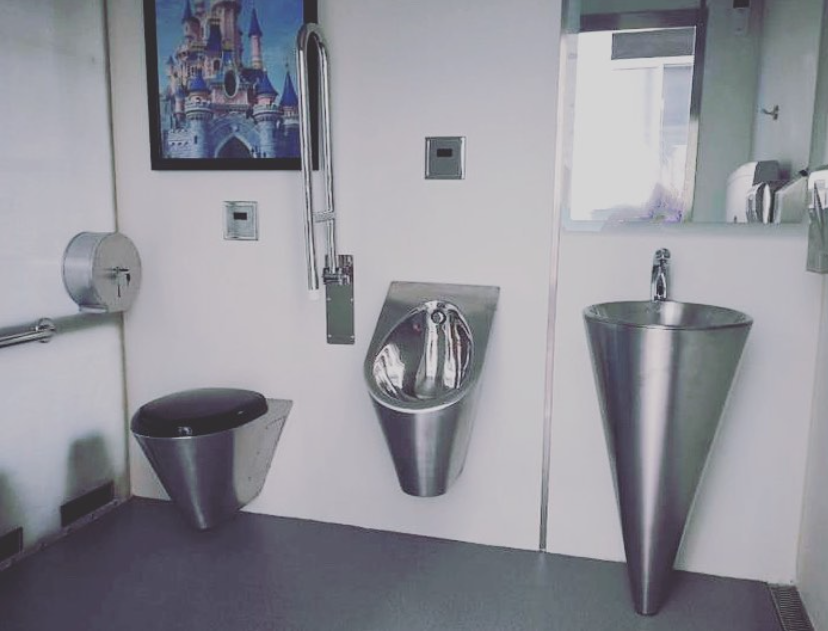In the world of public facilities, one design choice stands out for its practicality and longevity: the use of stainless steel in public toilets. Whether you're visiting a bustling city park, a busy train station, or a modern shopping mall, chances are you've encountered a stainless steel toilet. But why is this material so prevalent in public restrooms? What makes it the go-to choice for designers, architects, and facility managers? In this in-depth article, we'll explore the reasons behind the widespread adoption of public toilets in public spaces, diving into aspects like durability, hygiene, cost-effectiveness, and aesthetics. By the end of this piece, you'll have a newfound appreciation for the humble public toilet and understand why it's here to stay in our public restrooms.
Today, stainless steel toilets are a common sight in airports, stadiums, office buildings, and transit hubs. Their adoption reflects a broader shift toward materials that can withstand heavy use while maintaining a clean and presentable appearance. But what exactly sets stainless steel apart from other options? Let's delve into the key factors that make it the material of choice for public restrooms.
One of the most compelling reasons for using stainless steel in public toilets is its exceptional durability. Public restrooms face unique challenges: they're subjected to constant use, accidental impacts, and even acts of vandalism. In such environments, materials must be robust enough to endure these stresses without frequent replacement.
Public toilets in airports, train stations, and sports arenas see thousands of users daily. In such high-traffic environments, fixtures must withstand constant use without failing. Stainless steel excels here, as it can handle repeated flushing, cleaning, and physical contact without degrading. Unlike porcelain, which can crack or chip under pressure, stainless steel maintains its shape and functionality, even after years of heavy use.
This longevity translates to significant cost savings for facility managers. While public toilets may have a higher upfront cost compared to their ceramic counterparts, their long lifespan and low maintenance requirements make them a more economical choice in the long run. For institutions with limited budgets, this cost-effectiveness is a critical factor in material selection.
While durability and hygiene are primary drivers of stainless steel's adoption, its aesthetic qualities should not be overlooked. In modern public spaces, design plays a significant role in creating a welcoming and professional atmosphere. Stainless steel toilets contribute to this goal by offering a sleek, contemporary look that complements various architectural styles.
While the initial investment in public toilets may be higher than alternatives like porcelain, their long-term cost benefits make them a financially sound choice. Facility managers and budget-conscious institutions recognize this value, as stainless steel delivers savings in several key areas.
In high-traffic public restrooms, fixtures are prone to damage and wear. Porcelain toilets, for instance, can crack or chip with regular use, necessitating costly replacements. Stainless steel toilets, however, withstands such stresses, reducing the frequency of replacements. Over time, this translates to significant savings, as the material's durability minimizes the need for costly repairs or upgrades.
Public restrooms must serve diverse populations, including individuals with disabilities, elderly users, and families with young children. Stainless steel toilets contribute to inclusive design by offering features that enhance safety and accessibility.
Stainless steel's strength makes it ideal for supporting users who require additional stability. Features like grab bars and reinforced seats can be seamlessly integrated into stainless steel toilet designs, providing essential support for individuals with disabilities. These fixtures not only enhance safety but also ensure compliance with accessibility standards like the Americans with Disabilities Act (ADA).
To better understand the practical benefits of stainless steel toilets, let's examine real-world applications where this material has proven its worth.
In major cities like New York, London, and Tokyo, transit stations serve millions of passengers daily. Restrooms in these hubs must withstand constant use, vandalism, and harsh environmental conditions. Stainless steel toilets have become the standard in such settings, praised for their durability and low maintenance requirements. Facility managers report that these fixtures require fewer replacements and less frequent repairs, reducing operational costs significantly.
During events, restrooms in sports venues experience extreme traffic, with users often in a hurry or less mindful of facility care. public toilets excel in these environments, absorbing impacts and resisting damage from accidental or deliberate misuse. Their corrosion resistance is also beneficial in areas where restrooms may be exposed to weather or high humidity levels.
Hospitals and clinics prioritize hygiene above all else, and stainless steel toilets have become a staple in these settings. Their antimicrobial properties and ease of cleaning make them ideal for environments where infection control is critical. Additionally, their durability ensures that restrooms remain functional during peak usage periods, such as emergency room visits or patient influxes.
As technology advances, so too does the potential of stainless steel in public restrooms. Innovations in material science and design are continually enhancing the functionality and appeal of stainless steel toilets, ensuring their relevance in tomorrow's public spaces.
Manufacturers are developing stainless steel products with customizable features, allowing facilities to tailor fixtures to specific needs. Additionally, advancements in recycling and sustainable production methods are making stainless steel an even more environmentally friendly choice. These innovations position public toilets as a key component of future-oriented, eco-conscious public spaces.
In the complex ecosystem of public restrooms, public toilets stand out as a solution that balances durability, hygiene, aesthetics, and cost-effectiveness. Their ability to thrive in high-traffic, challenging environments while maintaining a clean and modern appearance makes them indispensable in today's public spaces. As cities and institutions continue to evolve, stainless steel will remain at the forefront of restroom design, offering a material that meets the demands of modern public life with reliability and grace.
Whether you're a facility manager, architect, or simply a user of public restrooms, understanding the benefits of stainless steel toilets provides insight into why this material has become a cornerstone of public infrastructure. Its combination of practicality and elegance ensures that stainless steel toilets will continue to serve communities worldwide, setting the standard for public restroom design for generations to come.

